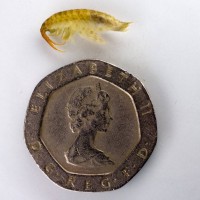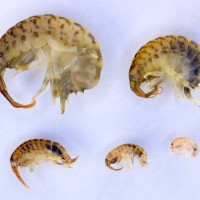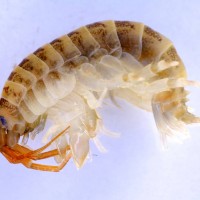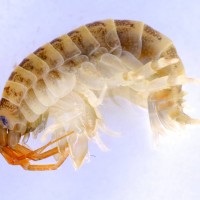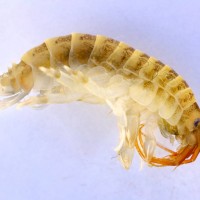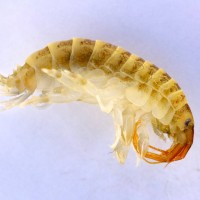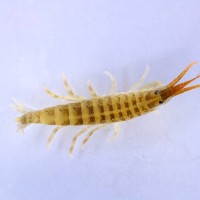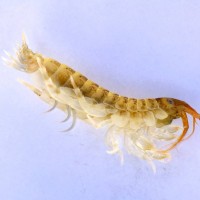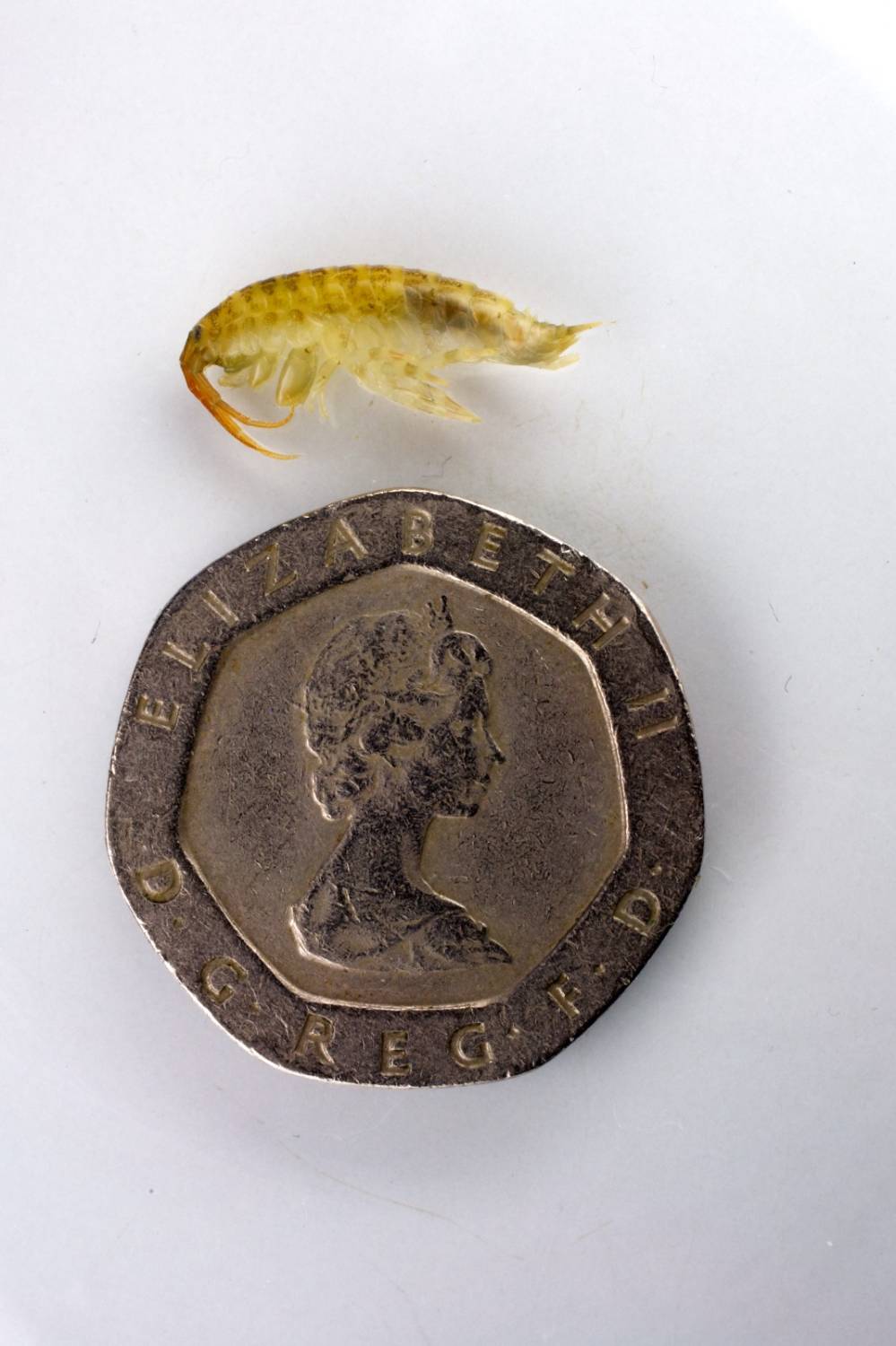
Killer Shrimp - Dikerogammarus villosus
Expand and collapse the sections below by clicking on the title or + / - icons.
Short description of Dikerogammarus villosus, Killer Shrimp
Adults are up to 30mm in length. The body is curled and semi-transparent. They have two pairs of antennae and large, powerful mandibles. Newly hatched young are about 1.8mm in length and resemble adults.
Impact summary: Dikerogammarus villosus, Killer Shrimp
Killer shrimps are voracious predators of native shrimp and a wide range of other native fauna. They are likely to disrupt ecosystems through direct predation and also indirect effects across trophic levels. Loss of diversity could affect assessments of water quality. Changes in trophic interactions could alter distributions of fish, whilst parasites carried by killer shrimps could reduce fish stocks.
Habitat summary: Dikerogammarus villosus, Killer Shrimp
While currently restricted, there are large areas of GB’s canals, rivers and lakes that would provide suitable habitat for the species. They require hard banks, slow flowing water and are salt tolerant so can also colonise brackish coastal habitats.
Overview table
| Environment | Freshwater |
|---|---|
| Species status | Non-Native |
| Native range | Russian Far East, Caucasus, Russia South, Ukraine |
| Functional type | Predator |
| Status in England | Non-Native |
| Status in Scotland | |
| Status in Wales | Non-Native |
| Location of first record | Grafham Water reservoir, Cambridgeshire |
| Date of first record | 2010 |
Origin
Ponto-Caspian: native range is in the lower courses of large rivers in the Black and Caspian Sea basins.
First Record
Grafham Water Reservoir, Cambridgeshire, September 2010.
Pathway and Method
Spread through natural range expansion and transportation in ballast waters after the opening of the Danube-Main-Rhine canal in 1992. Surfaces such as waders, boats and angling equipment are vulnerable to fouling and could transport the species between water bodies within GB. The species could be transferred with movements of fish stocks or foraging water birds.
Species Status
The species was first found in the upper Danube in 1992 and in the lower Rhine soon after. It has successfully invaded Germany, France, Italy, Switzerland, Belgium, The Netherlands, Hungary, Austria and the Czech Republic. Killer shrimp has colonised regions such as northern France and The Netherlands that are very similar bioclimatically to much of Britain’s freshwaters, making it likely that invasion of British waters will be successful if the species is introduced. The Cambridgeshire and Welsh populations are very well established.
Dispersal Mechanisms
It is estimated that the species can spread at a mean rate of 124 km per year downstream and 30-40 km per year upstream. Dispersal is likely to be facilitated by human activities such as shipping, boating and angling; D. villosus fouls surfaces and is carried in ballast water. The species may also disperse downstream by drift. Transportation by birds is also possible. Recent expansion of the waterways network across Europe is likely to have facilitated spread.
Reproduction
Females may produce up to 200 eggs, however most produce less than 50 at a time. Reproduction happens when water temperature reaches 13ºC. There may be three reproductive peaks per year but highest fecundity has been recorded in April and May when food is plentiful and water temperatures are rising. Individuals reach maturity between 4 and 8 weeks old, at a length of 6mm.
Known Predators/Herbivores
Trout and perch predate killer shrimps. No known invertebrate predators.
Resistant Stages
Adults can tolerate salinities of up to 20 ppt, can acclimate quickly to changes in ionic concentration and may have a wide temperature tolerance. Temperature tolerance is likely to be reduced when exposed to low ion concentrations.
Habitat Occupied in GB
Killer shrimps currently occupy reservoir habitats. They are mainly found in habitats with an artificial bank structure, high oxygen saturation and a low conductivity. They select hard structures such as stones, cobbles and tree roots and are also thought to be associated with zebra mussel beds. Many GB canals, rivers and reservoirs would therefore provide suitable habitat. Given their high salt tolerance the species could potentially penetrate brackish zones of GB rivers. The species is not typically found on sandy substratum or in areas with high current velocity.
Environmental Impact
Killer shrimp is a highly aggressive and voracious predator and is regarded as one of the most damaging invasive species in Western Europe. The species affects ecosystems through direct predation and through cascading indirect effects across trophic levels. Killer shrimp is a major predator of native shrimps, other invasive shrimps, mayflies, damselflies, leeches, chironomids, cladocera, isopods, snails, fish eggs and larvae. Sometimes macroinvertebrates are killed but not eaten, perhaps in order to remove competitors. Killer shrimps are also coprophagus, feed on detrital material and have been observed to eat zebra mussel byssus threads. It is likely that macroinvertebrate populations will decline and services such as leaf shredding and nutrient processing will be affected. However, other species may benefit from the increase in prey abundance as killer shrimp populations increase.
Health and Social Impact
Loss of diversity through ecosystem impacts could affect scoring of water quality using biological metrics and have implications for the Water Framework Directive, however supply of drinking water is unlikely to be affected.
Economic Impact
Killer shrimp is likely to affect the quality and distribution of fisheries. Observations suggest that trout and perch are feeding increasingly on Killer shrimp, which could drive changes in distribution of fish and catchability for anglers. The shrimp may also serve as an intermediate host for acanthodephalan parasites including Echinorhyneys truttae and Pomphorynclus laevis which cause disease in salmonids and reduce fishery value.
Identification
www.europe-aliens.org DAISIE database of the 100 worst invaders. Accessed 14th September 2010.
Biology, ecology, spread, vectors
Berezina, N.A., Duris, Z. (2008) First record of the invasive species Dikerogammarus villosus (Crustacea: Amphipoda) in the Vlatava River (Czech Republic), Aquatic Invasions, 3, 455-460.
Bij de Vaate, A., Jazdzewski, K., Ketelaars, H.A.M., Gollasch, S. & Van der Velde, G. (2002) Geographical patterns in range extension of Ponto-Caspian macroinvertebrate species in Europe. Canadian Journal of fisheries and aquatic sciences, 59(7), 1159-1174.
Boets, P., Lock, K., Messiaen, M. & Goethals, P.L.M. (2010) Combining data-driven methods and lab studies to analyse the ecology of Dikerogammarus villosus. Ecological Informatics, 5(2), 133-139.
Bollache, L. (2004) Dikerogammarus villosus (Crustacea : Amphipoda): another invasive species in Lake Geneva. Revue suisse de zoologie, 111, 309-313.
Brooks, S.J., Platvoet, D., Mills, C.L. (2008) Cation regulation and alteration of water permeability in the amphipod Dikerogammarus villosus: an indicator of invasion potential. Fundamental and applied limnology, 172, 183-189.
Brown, A. (2011) Anglian Water, pers. comm.
Bruijs, M.C.M., Kelleher, B., van der Velde, G., de Vaate, A.B. (2001) Oxygen consumption, temperature and salinity tolerance of the invasive amphipod Dikerogammarus villosus: indicators of further dispersal via ballast water transport, Archiv fur Hydrobiologie, 152, 633-646.
Casellato, S., La Piana, G., Latella, L., Ruffo, S. (2006) Dikerogammarus villosus (Sowinsky, 1894) (Crustacea, Amphipoda,Gammaridae) for the first time in Italy. Italian Journal of Zoology, 73, 97-104.
Devin, S., Piscart, C., Beisel, J.N. & Moreteau, J.C. (2003) Ecological traits of the amphipod invader Dikerogammarus villosus on a mesohabitat scale. Archiv fur Hydrobiologie, 158(1), 43-56.
Devin, S., Piscart, C., Beisel, J.N., Moreteau, J.C. (2004) Life history traits of the invader Dikerogammarus villosus (Crustacea : Amphipoda) in the Moselle River, France. International review of Hydrobiology, 89, 21-34.
Ermgassen, P.S.E.Z., Leuven, R.S.E.W., Aldridge, D.C., Minchin, D., Keller, R.P., van der Velde, G. (in review) Changing patterns in island hopping invaders.
Gergs, R., Rothhaupt, K.O. (2008) Effects of zebra mussels on a native amphipod and the invasive Dikerogammarus villosus: the influence of biodeposition and structural complexity. Journal of the North American Benthological Society, 27, 541-548.
Gittenberger, E., Groenenberg, D.S.J., Kokshoorn, B., et al. (2006) Molecular trails from hitch-hiking snails. Nature, 439, 409-409.
Hesselschwerdt, J., Necker, J., Wantzen, K.M. (2008) Gammarids in Lake Constance: habitat segregation between the invasive Dikerogammarus villosus and the indigenous Gammarus roeselii. Fundamental and Applied Limnology, 173, 177-186.
Josens, G., de Vaate, A.B., Usseglio-Polatera, P., Cammaerts, R., Cherot, F., Grisez, F., Verboonen, P., Bossche, J.P.V. (2005) Native and exotic Amphipoda and other Peracarida in the River Meuse: new assemblages emerge from a fast changing fauna. Hydrobiologia, 542, 203-220.
Kinzler, W., Kley, A., Mayer, G., Waloszek, D., Maier, G. (2009) Mutual predation between and cannibalism within several freshwater gammarids: Dikerogammarus villosus versus one native and three invasives. Aquatic Ecology, 43, 457-464.
Kley, A., Maier, G. (2003) Life history characteristics of the invasive freshwater gammarids Dikerogammarus villosus and Echinogammarus ischnus in the river Main and the Main-Donau canal. Archiv fur Hydrobiologie, 156, 457-469.
Leuven, R.S.E.W., van der Velde, G., Baijens, I., Snijders, J., van der Zwart, C., Lenders, H.J.R., de Vaate, A.B. (2009) The river Rhine: a global highway for dispersal of aquatic invasive species. Biological Invasions, 11, 1989-2008.
MacNeil, C., Platvoet, D., Dick, J.T.A. (2008) Potential roles for differential body size and microhabitat complexity in mediating biotic interactions within invasive freshwater amphipod assemblages. Fundamental and Applied Limnology, 172, 175-182.
Mordukhai-Boltovski, F.D. (1969) Besonderheiten der kapischen Fauna im Bassin der Donau. Limnologische Donauforschungen, Kiev, 98-105.
Musko, I.B., Balogh, C., Toth, A.P., Varga, E. & Lakatos, G. (2007) Differential response of invasive malacostracan species to lake level fluctuations. Invasive Crustacea, 590(1), 65-74.
Neeseman, H., Pockl, M., Wittmann, K.J. (1995) Distribution of epigean Malacostraca in the middle and upper Danube (Hungary, Austria, Germany). Miscellenea Zoologica Hungarica, 10, 49-68.
Piscart, C., Bergerot, B., Laffaille, P., Marmonier, P. (2010) Are amphipod invaders a threat to regional biodiversity? Biological Invasions, 853-863.
Pockl, M. (2007) Strategies of a successful new invader in European fresh waters: fecundity and reproductive potential of the Ponto-Caspian amphipod Dikerogammarus villosus in the Austrian Danube, compared with the indigenous Gammarus fossarum and G-roeseli. Freshwater Biology, 52, 50-63.
Talbot, M., Pathan, N., Owen, J., Hundle, B. & Grove, J. (2009) Transport Statistics Report. Maritime Statistics 2008 (The Stationary Office, London), (Department for Transport).
Tricarico, E., Mazza, G., Orioli, G., Rossano, C., Gherardi, F. (2010) The killer shrimp, Dikerogammarus villosus (Sowinsky, 1894), is spreading in Italy. Aquatic Invasions, 5, 211-214.
Wijnhoven, S., van Riel, M.C., van der Velde, G. (2003) Exotic and indigenous freshwater gammarid species: physiological tolerance to water temperature in relation to ionic content of the water. Aquatic Ecology, 37, 151-158.
Management and impact
Aldridge, D.C., Elliott, P., Moggridge, G.D. (2006) Microencapsulated BioBullets for the control of biofouling zebra mussels. Environmental Science and Technology, 40, 975-979.
Arndt, E., Fiedler, S., Bohme, D. (2009) Effects of invasive benthic macroinvertebrates on assessment methods of the EU Water Frame Work Directive. Hydrobiologia, 635, 309-320.
Bruijs, M.C.M., Kelleher, B., van der Velde, G., de Vaate, A.B. (2001) Oxygen consumption, temperature and salinity tolerance of the invasive amphipod Dikerogammarus villosus: indicators of further dispersal via ballast water transport. Archiv fur Hydrobiologie, 152, 633-646.
Bollache, L., Dick, J.T.A., Farnsworth, K.D. & Montgomery, W.I. (2008) Comparison of the functional responses of invasive and native amphipods. Biology Letters, 4(2), 166-169.
Dick, J., Queen’s University, pers. comm..
Dick, J.T.A., Platvoet, D., Kelly, D.W. (2002) Predatory impact of the freshwater invader Dikerogammarus villosus (Crustacea : Amphipoda). Canadian Journal of Fisheries and Aquatic Sciences, 59, 1078-108.
Dick, J.T.A., Platvoet, D. (2000) Invading predatory crustacean Dikerogammarus villosus eliminates bath native and exotic species. Proc. Roy. Soc. B, 267, 977-983.
Dunn, A., University of Leeds, pers. comm..
Kelleher, B., Bergers, P.J.M., van den Brink, F.W.B., Giller, P.S., van der Velde, G., de Vaate, A.B. (1998) Effects of exotic amphipod invasions on fish diet in the Lower Rhine. Archiv fur Hydrobiologie, 143, 363-382.
MacNeil, C. & Platvoet, D. (2005) The predatory impact of the freshwater invader Dikerogammarus villosus on native Gammarus pulex (Crustacea: Amphipoda); influences of differential microdistribution and food resources. Journal of Zoology, 267(1), 31-38.
MacNeil, C., Platvoet, D., Dick, J.T.A. (2008) Potential roles for differential body size and microhabitat complexity in mediating biotic interactions within invasive freshwater amphipod assemblages. Fundamental and Applied Limnology, 172, 175-182.
MacNeil, C., Dick, J.T.A., Platvoet, D., Briffa, M. (in review) Direct and indirect effects of displacement; an invading freshwater amphipod can disrupt leaf litter processing and shredder efficiency.
Noordhuis, R., van Schie, J., Jaarsma, N. (2009) Colonization patterns and impacts of the invasive amphipods Chelicorophium curvispinum and Dikerogammarus villosus in the IJsselmeer area, The Netherlands. Biological Invasions, 11, 2067-2084.
Platvoet, D., van der Velde, G., Dick, J.T.A. & Shuqiang (2009) Flexible omnivory in Dikerogammarus villosus (Sowinsky 1894) – Amphipod Pilot Species Project (AMPIS) Report 5. Crustaceana, 82(6), 703-720.
General
Croiser, DM, Molloy, DP, Bij de Vaate, A and Devin, S. Report: Killer Shrimp - Dikerogammarus villosus. http:el.erdc.usace.army.milansrpdikerogammarus_villosus.pdf
MacNeil, C., Platvoet, D., Dick, J.T., Fielding, N., Constable, A., Hall, N., Aldridge, D., Renals, T. & Diamond, M. (2010) The Ponto-Caspian ‘killer shrimp’, Dikerogammarus villosus (Sowinsky, 1894), invades the British Isles. Aquatic Invasions, 5, 441-445.
Spotted this species?
Distribution map
View the Distribution map for Killer Shrimp, Dikerogammarus villosus from NBN Atlas
Risk assessment
Risk assessment for Dikerogammarus villosus. See a full list of non-native species Risk assessments.

